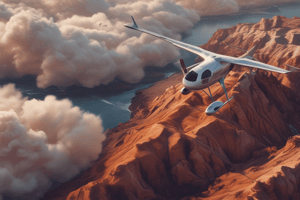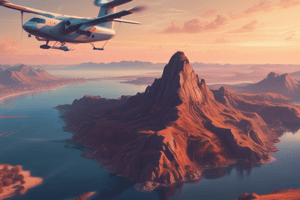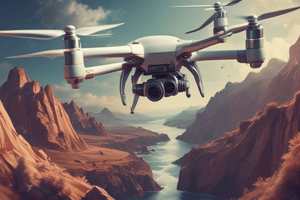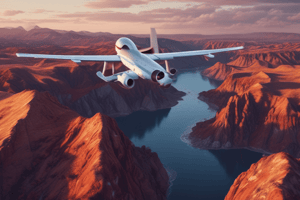Podcast
Questions and Answers
When is it acceptable to not use an ND filter?
When is it acceptable to not use an ND filter?
- When the light is too harsh
- When using a drone with a built-in filter
- When it's overcast (correct)
- When shooting at high altitudes
What is the recommended shutter speed for capturing smooth shots?
What is the recommended shutter speed for capturing smooth shots?
- The same as the frame rate
- Double the frame rate (correct)
- Quarter the frame rate
- Half the frame rate
Why is it recommended to only shoot selects?
Why is it recommended to only shoot selects?
- To have more options for editing
- To capture more footage
- To reduce the drone's battery life
- To avoid capturing unnecessary footage (correct)
What is the purpose of recording 10-15 seconds after the select?
What is the purpose of recording 10-15 seconds after the select?
What is essential for mastering smooth shots?
What is essential for mastering smooth shots?
What is NOT covered in this aerial videography course?
What is NOT covered in this aerial videography course?
Who is the instructor of this aerial videography course?
Who is the instructor of this aerial videography course?
The course will cover subject tracking in aerial videography.
The course will cover subject tracking in aerial videography.
It is recommended to use an ND filter even when it's overcast.
It is recommended to use an ND filter even when it's overcast.
The auto exposure lock button should be hit before setting up the shot.
The auto exposure lock button should be hit before setting up the shot.
Recording every shot and watching it is necessary to master smooth shots.
Recording every shot and watching it is necessary to master smooth shots.
The course is designed to teach students how to capture cinematic shots only from one specific drone.
The course is designed to teach students how to capture cinematic shots only from one specific drone.
Paul Aken is the instructor of a course offered by Drone U.
Paul Aken is the instructor of a course offered by Drone U.
The course will cover equipment settings and techniques for capturing smooth shots.
The course will cover equipment settings and techniques for capturing smooth shots.
What should be done before taking off to ensure a safe landing?
What should be done before taking off to ensure a safe landing?
What is the primary purpose of using a landing pad?
What is the primary purpose of using a landing pad?
What should be checked during pre-flight checks to eliminate liability?
What should be checked during pre-flight checks to eliminate liability?
What should be avoided when flying a drone?
What should be avoided when flying a drone?
What is an essential accessory for drone operations?
What is an essential accessory for drone operations?
What should be done to the gear after flying?
What should be done to the gear after flying?
Why should you scout locations before filming?
Why should you scout locations before filming?
What should be done before flying to get comfortable?
What should be done before flying to get comfortable?
Checking the environment, including measuring tree heights, is not necessary for maintaining visual line of sight.
Checking the environment, including measuring tree heights, is not necessary for maintaining visual line of sight.
Flying over people is allowed if you have their permission.
Flying over people is allowed if you have their permission.
Setting up camera and video parameters before taking off is not necessary.
Setting up camera and video parameters before taking off is not necessary.
A landing pad is only necessary for taking off.
A landing pad is only necessary for taking off.
Warming up hands and sticks before flying is a waste of time.
Warming up hands and sticks before flying is a waste of time.
Scouting locations before filming is a waste of time.
Scouting locations before filming is a waste of time.
Put away your gear carelessly after flying to save time.
Put away your gear carelessly after flying to save time.
You do not need to check propellers before taking off.
You do not need to check propellers before taking off.
When moving a drone, it's essential to match the speed of one motion to another to create a natural look.
When moving a drone, it's essential to match the speed of one motion to another to create a natural look.
The Mavic 3 has full camera control, which allows users to adjust settings freely.
The Mavic 3 has full camera control, which allows users to adjust settings freely.
The Inspire 2 X7 has a native 4:3 sensor, which is ideal for wide shots and cinematic footage.
The Inspire 2 X7 has a native 4:3 sensor, which is ideal for wide shots and cinematic footage.
Orbits are a fundamental motion in videography, and there are only 5-10 different types of orbit flights.
Orbits are a fundamental motion in videography, and there are only 5-10 different types of orbit flights.
The aspect ratio of 2.44:1 is commonly used for TV and YouTube videos.
The aspect ratio of 2.44:1 is commonly used for TV and YouTube videos.
To achieve smooth shots, use an ND filter and set up the tilt quickly.
To achieve smooth shots, use an ND filter and set up the tilt quickly.
Take off with the wind for extra safety precautions.
Take off with the wind for extra safety precautions.
Return to home altitude (100) for extra safety precautions.
Return to home altitude (100) for extra safety precautions.
Elevate slowly while tilting up on the tilt wheel to create a smooth motion.
Elevate slowly while tilting up on the tilt wheel to create a smooth motion.
Practice makes perfect, but it's not necessary to experiment with different focal lengths and angles.
Practice makes perfect, but it's not necessary to experiment with different focal lengths and angles.
What is essential to achieve smooth shots?
What is essential to achieve smooth shots?
What is the correct rule for takeoff?
What is the correct rule for takeoff?
What is the purpose of descending slowly while tilting up on the tilt wheel?
What is the purpose of descending slowly while tilting up on the tilt wheel?
What is the recommended approach to improve smoothness?
What is the recommended approach to improve smoothness?
What is the technique called when flying low over an object, then elevating and tilting up?
What is the technique called when flying low over an object, then elevating and tilting up?
Flashcards are hidden until you start studying
Study Notes
Aerial Videography Course
- The course is designed to help students master the confidence to capture smooth shots, including crane shots, reveal shots, sliding shots, orbital shots, and more.
Key Settings for Smooth Shots
- Always use an ND filter unless it's overcast.
- Ensure shutter speed is double the frame rate.
- Don't forget to hit the auto exposure lock button.
Recording Tips
- Only shoot selects to avoid capturing unnecessary footage.
- Set up the shot, click record, make the shot, and then click record again.
- Some pilots record for 10-15 seconds after the select to have a nice transition or buffer footage.
Importance of Practice
- Practice makes perfect, and it's essential to practice these shots in the field to master them.
- Record every shot and watch it to improve.
Course Overview
- The course will cover settings, equipment, and techniques for capturing beautiful, smooth, cinematic shots.
- It will not cover subject tracking, which is a separate course.
- It will cover various shots and sequences from different drones to demonstrate different looks.
Instructor and Course
- The course is taught by Paul Aken, and it's offered by Drone U.
Aerial Videography Course
- The course aims to equip students with the confidence to capture various smooth shots, including crane shots, reveal shots, sliding shots, and orbital shots.
Key Settings for Smooth Shots
- Use an ND filter in all conditions except overcast weather.
- Set the shutter speed to twice the frame rate.
- Don't forget to press the auto exposure lock button.
Recording Tips
- Only capture selective footage to avoid unnecessary recordings.
- Record footage in a specific sequence: set up the shot, click record, make the shot, and then click record again.
- Record an additional 10-15 seconds after the select to get a smooth transition or buffer footage.
Importance of Practice
- Consistent practice in the field is crucial to master smooth shots.
- Record every shot and review it to improve.
Course Overview
- The course covers settings, equipment, and techniques for capturing cinematic shots.
- The course does not cover subject tracking, which is a separate course.
- The course features various shots and sequences from different drones to demonstrate different visual styles.
Instructor and Course
- The course is taught by Paul Aken.
- The course is offered by Drone U.
Aerial Videography Course
- The course aims to equip students with the confidence to capture various smooth shots, including crane shots, reveal shots, sliding shots, and orbital shots.
Key Settings for Smooth Shots
- Use an ND filter in all conditions except overcast weather.
- Set the shutter speed to twice the frame rate.
- Don't forget to press the auto exposure lock button.
Recording Tips
- Only capture selective footage to avoid unnecessary recordings.
- Record footage in a specific sequence: set up the shot, click record, make the shot, and then click record again.
- Record an additional 10-15 seconds after the select to get a smooth transition or buffer footage.
Importance of Practice
- Consistent practice in the field is crucial to master smooth shots.
- Record every shot and review it to improve.
Course Overview
- The course covers settings, equipment, and techniques for capturing cinematic shots.
- The course does not cover subject tracking, which is a separate course.
- The course features various shots and sequences from different drones to demonstrate different visual styles.
Instructor and Course
- The course is taught by Paul Aken.
- The course is offered by Drone U.
Drone Operations and Safety
- Establish a pre-flight check system to minimize liability and ensure safe flights.
- Consider environmental factors, including tree height measurements, to maintain visual line of sight and identify safe landing spots.
- Avoid flying over people and disturbing wildlife, using best judgment.
- Perform pre-flight checks on propellers, obstacle avoidance sensors, and GPS to ensure proper function.
Pre-Flight Checks
- Inspect propellers for damage or wear.
- Clean camera and sensors to ensure optimal performance.
- Verify good GPS signal before taking off.
- Set camera and video parameters before flight.
Drone Accessories
- Essential accessories include:
- ND filters (e.g., ND8 or ND16) depending on light conditions.
- Spare propellers.
- Lens cloth for cleaning.
- Landing pad for protecting the gimbal from damage.
Flying Tips
- Warm up hands and sticks before flying to improve control.
- Start with simple shots (orbits, reveals, tilts) to get comfortable with drone handling.
- Take off and land discreetly to avoid drawing attention.
- Perform takeoffs and landings low and quickly to minimize visibility.
General Tips
- Properly store and maintain gear to prevent damage.
- Scout filming locations beforehand to understand the environment and identify different perspectives.
- Have all necessary accessories ready and easily accessible.
Drone Operations and Safety
- Establish a pre-flight check system to minimize liability and ensure safe flights.
- Consider environmental factors, including tree height measurements, to maintain visual line of sight and identify safe landing spots.
- Avoid flying over people and disturbing wildlife, using best judgment.
- Perform pre-flight checks on propellers, obstacle avoidance sensors, and GPS to ensure proper function.
Pre-Flight Checks
- Inspect propellers for damage or wear.
- Clean camera and sensors to ensure optimal performance.
- Verify good GPS signal before taking off.
- Set camera and video parameters before flight.
Drone Accessories
- Essential accessories include:
- ND filters (e.g., ND8 or ND16) depending on light conditions.
- Spare propellers.
- Lens cloth for cleaning.
- Landing pad for protecting the gimbal from damage.
Flying Tips
- Warm up hands and sticks before flying to improve control.
- Start with simple shots (orbits, reveals, tilts) to get comfortable with drone handling.
- Take off and land discreetly to avoid drawing attention.
- Perform takeoffs and landings low and quickly to minimize visibility.
General Tips
- Properly store and maintain gear to prevent damage.
- Scout filming locations beforehand to understand the environment and identify different perspectives.
- Have all necessary accessories ready and easily accessible.
Videography Basics
- Natural-looking motion is achieved by matching the speed of one motion to another.
- Avoid "exterior pan" shots, which involve panning and moving out, as they can be unattractive.
Framing and Composition
- Grid lines and diagonals on the drone help with framing and composition.
- Placing the subject in the center of the frame can make orbits easier, but placing them in the one-third frame can create a more interesting shot.
- Experimenting with different framing and composition techniques creates a unique mood and story.
Drone Setup
- Mavic 3 has a ND filter that can be rotated to remove or put back on.
- Mavic 3 interface allows for easy switching between photo and video modes.
- Gimbal settings on the Mavic 3 can be adjusted to control tilt speed and smoothness.
- Mavic 3 has a maximum altitude and distance setting, and a safety menu with features like auto return to home.
Camera Settings
- Mavic 3 camera settings can be adjusted to control shutter speed, aperture, and exposure value.
- Filming in 4K at 60 frames per second provides more editing flexibility.
- Mavic 3 does not have full camera control, limiting user's ability to adjust settings.
Drone Comparison
- Inspire 2 X7 camera is a high-quality camera for cinematic footage.
- Inspire 2 X7 has a native super 35 sensor, ideal for wide shots and cinematic footage.
- Inspire 2 X7 has better low-light performance and can shoot in a 2.44:1 aspect ratio.
Aspect Ratio
- Aspect ratio is the proportional relationship between image width and height.
- 16x9 is a common aspect ratio for TV and YouTube videos.
- 2.35:1 or 2.44:1 is a cinematic aspect ratio used in movie production.
Drone Operation
- Camera and settings should be set up before taking off.
- Inspire 2 requires a perfectly flat surface for calibration.
- Drone's props and batteries should be checked and replaced as needed.
Photo and Video Mode
- Photo and video modes should be set up before taking off.
- Photo mode can be set up to shoot in AEB and RAW format.
- Video mode can be set up to shoot in 2.44:1 aspect ratio and 30 frames per second.
Acquiring Smooth Drone Shots
- Use an ND filter and set up the tilt smoothly to achieve smooth shots.
- Consider the director's or producer's requests to ensure flight plans and paths align with their vision.
- Flying super straight lines and slow speeds can help create smooth shots.
Rules of Takeoff
- Take off into the wind to ensure a safe and stable start.
- Ensure the pilot and drone have the same orientation to avoid inadvertent motions.
- Perform a control sweep and battery test upon takeoff to ensure all systems are functioning properly.
Safety Precautions
- Return to a safe altitude of 246 feet for extra safety precautions.
- Monitor battery information and perform regular battery tests to avoid unexpected landings.
Flight Motions
- Descend slowly while tilting up on the tilt wheel to create smooth motions.
- Match speed with elevation to create smooth and controlled motions.
- Start recording before descending or elevating to capture the full shot.
Shots and Techniques
- Descending Crane Shot: Descend while tilting up on the tilt wheel.
- Ascending Crane Shot: Elevate while tilting down on the tilt wheel.
- Upper Tilting Reveal: Tilt down slowly, then pitch forward and elevate.
- Histogram Shot (also known as Waveform Shot): Fly low over an object, then elevate and tilt up.
- Slide: Roll to the right, then elevate and tilt up.
- Rotating Reveal: Roll to the right, then yaw to the left, and elevate.
- Orbit: Roll to the right, yaw to the left, and elevate.
- Boomerang Shot: Combine an orbit with an upper tilting reveal.
- Obstacle Shot: Fly close to an obstacle, then reveal the surrounding area.
Tips and Tricks
- Practice regularly to improve smoothness and shot quality.
- Consider flight paths, altitudes, and angles to add complexity and variation to shots.
- Use meditation, breathing exercises, or taking a walk to calm your hands and improve smoothness.
- Experiment with different focal lengths, altitudes, and angles to find what works best for your shots.
- Don't be afraid to get creative and try new things!
Acquiring Smooth Drone Shots
- Use an ND filter and set up the tilt smoothly to achieve smooth shots.
- Consider the director's or producer's requests to ensure flight plans and paths align with their vision.
- Flying super straight lines and slow speeds can help create smooth shots.
Rules of Takeoff
- Take off into the wind to ensure a safe and stable start.
- Ensure the pilot and drone have the same orientation to avoid inadvertent motions.
- Perform a control sweep and battery test upon takeoff to ensure all systems are functioning properly.
Safety Precautions
- Return to a safe altitude of 246 feet for extra safety precautions.
- Monitor battery information and perform regular battery tests to avoid unexpected landings.
Flight Motions
- Descend slowly while tilting up on the tilt wheel to create smooth motions.
- Match speed with elevation to create smooth and controlled motions.
- Start recording before descending or elevating to capture the full shot.
Shots and Techniques
- Descending Crane Shot: Descend while tilting up on the tilt wheel.
- Ascending Crane Shot: Elevate while tilting down on the tilt wheel.
- Upper Tilting Reveal: Tilt down slowly, then pitch forward and elevate.
- Histogram Shot (also known as Waveform Shot): Fly low over an object, then elevate and tilt up.
- Slide: Roll to the right, then elevate and tilt up.
- Rotating Reveal: Roll to the right, then yaw to the left, and elevate.
- Orbit: Roll to the right, yaw to the left, and elevate.
- Boomerang Shot: Combine an orbit with an upper tilting reveal.
- Obstacle Shot: Fly close to an obstacle, then reveal the surrounding area.
Tips and Tricks
- Practice regularly to improve smoothness and shot quality.
- Consider flight paths, altitudes, and angles to add complexity and variation to shots.
- Use meditation, breathing exercises, or taking a walk to calm your hands and improve smoothness.
- Experiment with different focal lengths, altitudes, and angles to find what works best for your shots.
- Don't be afraid to get creative and try new things!
Studying That Suits You
Use AI to generate personalized quizzes and flashcards to suit your learning preferences.




